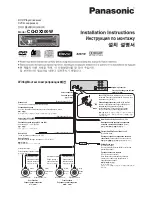
Crestron
QM-RMCRX-BA
QuickMedia™ Receiver/Processor
Appendix B: QuickMedia Installation and
Compensation
Installation Notes
You must pass audio through from transmitters to receivers even if you are not
using the audio signal. The information required for auto-compensation is
transmitted along with the audio. In addition, the QM Link signal indicates that
the QM cable is connected and that an audio signal is present on the cable. If a
unit does not receive an audio signal, the QM Link signal will not go high, and a
valid QM Link connection cannot be detected (video can still be displayed if
auto compensation is not used).
Certain devices terminate and re-initialize the audio path within the unit;
however, they pass on the video untouched. This creates different path lengths
for the video and audio. This difference in path length creates different peak and
boost levels for audio and video. When audio-breakaway is implemented, the
audio and video paths are likely to be different.
Compensation
Inherently, twisted pair cables experience a loss of bandwidth and signal
strength over distance. When the loss is within certain limits, the reduced signal
can be restored through peak and boost compensation adjustments. The amount
of required compensation is directly dependent on the length of the cable.
Therefore, each device in a network requires a specific amount of compensation.
Manual Compensation
In a manual compensation system, the compensation parameters, along with
microphone equalization settings, are stored in the receiver in a
preset
file.
When the program switches to a new transmitter, the program recalls the
compensation settings associated with the new transmitter. In large systems
containing multiple transmitters and receivers, these parameters must be stored
in multiple locations, creating a complex arrangement.
Auto Compensation
In a system utilizing auto compensation, the peak and boost values are stored in
a
preset
file at the receiver. The transmitter stores the input compensation and
microphone EQ settings. When the program switches to a new transmitter, the
transmitter ID, input compensation, and microphone EQ settings are sent over
the audio channel of the QM cable to the receiver. The receiver is equipped
with a hunt algorithm to search for the proper peak and boost settings. Once the
receiver acquires a QM Link signal, it can receive the audio signal containing
the transmitter ID, input compensation, and microphone EQ settings. After
receiving the transmitter ID, the receiver recalls the peak and boost preset and
uses these values to properly adjust the video signal.
NOTE:
If auto compensation is used in your QM system, all QM devices must
use it. If it is not used in your QM system, it must not be used for any of the QM
devices.
Operations Guide – DOC. 6332
QuickMedia™ Receiver/Processor: QM-RMCRX-BA
•
65
Содержание QM-RMCRX-BA
Страница 1: ...Crestron QM RMCRX BA QuickMedia Receiver Processor Operations Guide...
Страница 4: ......








































